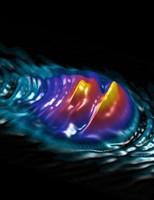 Attosecond
pulses are generated by electrons that are extracted from a quantum system by
an intense light pulse and travel through the continuum under the influence of
the electric field of the light. Portions
of each electron wave packet are forced to re-collide with its parent ion after
the field reverses direction. Upon
re-collision, the electron and ion can recombine, emitting soft X-ray radiation
that can be in the form of attosecond pulses.
This highly nonlinear process occurs in atoms, molecules and solids and offers
unique measurement opportunities – for measuring the attosecond pulse itself; the
orbital(s) from which it emerged; and the band structure of material in which
the wave packets moved.
Attosecond
pulses are generated by electrons that are extracted from a quantum system by
an intense light pulse and travel through the continuum under the influence of
the electric field of the light. Portions
of each electron wave packet are forced to re-collide with its parent ion after
the field reverses direction. Upon
re-collision, the electron and ion can recombine, emitting soft X-ray radiation
that can be in the form of attosecond pulses.
This highly nonlinear process occurs in atoms, molecules and solids and offers
unique measurement opportunities – for measuring the attosecond pulse itself; the
orbital(s) from which it emerged; and the band structure of material in which
the wave packets moved.
Attosecond pulse generation is a form of photoelectron spectroscopy but “in reverse”. It differs from conventional spectroscopy with an external source because the re-collision electron does not interact with core levels. Thus, we gain different information if we probe materials internally or conventionally with attosecond pulses. I will discuss the attosecond pulses that are created and the spectroscopy that arises.

